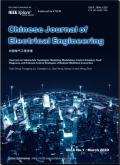Review of Lightweight Oriented Offshore Wind Power Transmission Schemes*
IF 3.5
Q1 Engineering
引用次数: 0
Abstract
The use of renewable energy is essential for addressing global climate change, and offshore wind power plays a critical role in achieving this goal. As nearshore resources become saturated, the focus of offshore wind power development is shifting to deep-sea areas. Deep-sea wind power transmission schemes must prioritize lightweight designs and low costs to enhance overall economic and technical feasibility. Currently, four lightweight offshore wind power transmission schemes have been identified: low-frequency alternating current (LFAC) transmission, high-voltage direct current (HVDC) transmission utilizing uncontrolled diode rectifier units (DRU-HVDC), DRU-MMC parallel-connection hybrid rectifier transmission (PCDRU-MMC), and DRU-MMC series-connection hybrid rectifier transmission (SCDRU-MMC). Four schemes are examined, advantages and disadvantages in various scenarios are outlined, technical performance are analyzed. A comprehensive economic assessment of each scheme is conducted for deep-sea environments far from load centers. The results indicate that LFAC transmission effectively reduces transmission losses, whereas DRU-HVDC has limitations in terms of voltage support and black-start capability. In contrast, hybrid rectification solutions such as PCDRU-MMC and SCDRU-MMC combine the economic benefits of DRU-HVDC with the flexibility of modular multilevel converters (MMCs), thereby enhancing system reliability and efficiency.轻量化海上风电传输方案综述*
可再生能源的使用对于应对全球气候变化至关重要,而海上风电在实现这一目标方面发挥着关键作用。随着近岸资源趋于饱和,海上风电开发的重点正在向深海地区转移。深海风电传输方案必须优先考虑轻量化设计和低成本,以提高整体经济和技术可行性。目前,已经确定了四种轻型海上风电传输方案:低频交流(LFAC)传输,高压直流(HVDC)传输利用非受控二极管整流单元(DRU-HVDC), DRU-MMC并联混合整流传输(PCDRU-MMC)和DRU-MMC串联混合整流传输(SCDRU-MMC)。对四种方案进行了研究,概述了各种场景下的优缺点,分析了技术性能。在远离负荷中心的深海环境下,对各方案进行了综合经济评价。结果表明,LFAC输电有效降低了输电损耗,而药- hvdc在电压支撑和黑启动能力方面存在局限性。相比之下,PCDRU-MMC和SCDRU-MMC等混合整流解决方案将DRU-HVDC的经济效益与模块化多电平变流器(mmc)的灵活性相结合,从而提高了系统的可靠性和效率。
本文章由计算机程序翻译,如有差异,请以英文原文为准。
求助全文
约1分钟内获得全文
求助全文
来源期刊

Chinese Journal of Electrical Engineering
Energy-Energy Engineering and Power Technology
CiteScore
7.80
自引率
0.00%
发文量
621
审稿时长
12 weeks
 求助内容:
求助内容: 应助结果提醒方式:
应助结果提醒方式:


